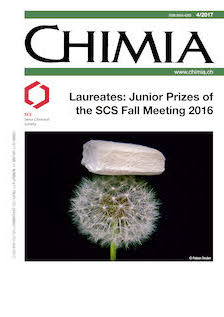DNA Polymerase Inhibition by High Kinetic Stability of T-HgII-T Base Pairs
DOI:
https://doi.org/10.2533/chimia.2017.181Keywords:
Base pair, Dna, Enzymatic catalysis, Fluorescence, Transition metalAbstract
A fluorescent surrogate of thymidine called DMAT was used for the first fluorescence-based study of HgII binding to discrete T-T sites in duplex DNA. The fluorescent properties of DMAT-A base pairs were highly sensitive to wild-type T-HgII-T base pair formation at an adjacent site, allowing for a determination of the precise thermodynamic and kinetic parameters of these metal binding reactions. T-HgII-T complexes exhibited equilibrium dissociation constants of Kd ? 8–50 nM. These high-affinity binding interactions are characterized by very slow association and dissociation kinetics (kon ? 104– 105 M–1s–1, koff ? 10–4 – 10–3s–1), revealing exceptionally high kinetic stabilities of T-HgII-T base pairs (half-lives = 0.3–1.3 h). Duplex DNA containing DMAT and no T-T mismatch exhibited nonspecific HgII binding affinities of Kd ? 2.0 ?M. The high kinetic stabilities of T-HgII-T resulted in the inhibition of dynamic processes such as DNA strand invasion and strand displacement during enzymatic DNA synthesis, which led to premature chain termination. These results demonstrated that T-HgII-T base pairs are kinetically distinct from T-A base pairs and therefore are likely to disrupt DNA metabolism in vivo.Downloads
Published
2017-04-26
Issue
Section
Scientific Articles
License
Copyright (c) 2017 Swiss Chemical Society

This work is licensed under a Creative Commons Attribution-NonCommercial 4.0 International License.
How to Cite
[1]
Chimia 2017, 71, 181, DOI: 10.2533/chimia.2017.181.







